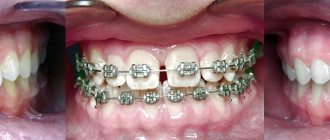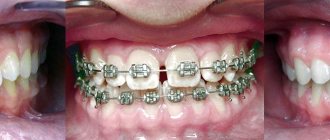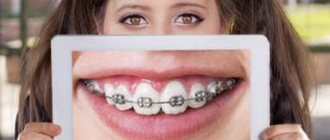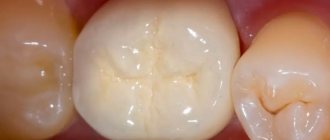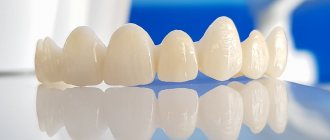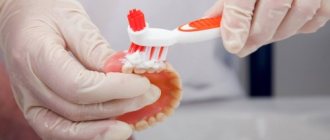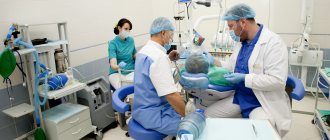Cleaning before braces: why is it needed?
Correction of the bite always begins with sanitation of the oral cavity. In addition to treating diseases of the teeth and gums, it includes mandatory professional cleaning before installing braces. The doctor will remove hard deposits with ultrasound, and soft deposits with a thin and powerful jet of cleaning powder solution (AirFlow technology). After this, the teeth will need to be polished with a special paste and coated with a fluoride-containing preparation to strengthen the enamel. Such a hygienic procedure should be carried out 3 - 5 days before installation, but no later than 24 hours.
What happens if you don’t brush your teeth before braces? Bacterial plaque will get under the elements of the system, in particular under the clasps that are glued to the enamel. Considering that orthodontic appliances are worn for a year at best, and two years on average, microorganisms will have enough time to multiply and lead to the formation of caries. It is impossible to properly cure it with braces on the teeth. There is a risk of early removal of the device, and this will spoil the final result, and the patient will waste money, time and moral strength. This is why brushing your teeth before getting braces is mandatory.
air flow
It is important to understand that you should start doing professional oral cleaning before installing orthodontic systems. As a rule, this is a prerequisite before starting treatment. In this case, any method of cleansing is suitable, since they all allow you to cope with hard deposits and small particles of food in the interdental spaces.
The Air Flow procedure is painless and cannot damage the structure of even the most fragile braces, so its use is approved by all dentists and orthodontists. Cleaning should be done when a large accumulation of plaque is detected, as well as to prevent its occurrence. However, even when using such technology, there are a number of nuances that should be taken into account.
Usually the doctor works with a regular aqueous solution, which is applied to the surface of the enamel under strong pressure. This jet instantly removes deposits and massages the gums well, improving blood circulation. The result after the procedure lasts for a long time.
Rules for caring for braces after installation
And finally, the orthodontic structure is put on. There are many months, or even years of treatment ahead, during which you will need to devote a lot of time to oral hygiene. Cleaning braces is not an easy task. An orthodontic apparatus is a complex system with many elements: clasps, arches, ligatures, rings, springs, hooks for elastic rods... And on each of them food particles can remain and plaque can accumulate.
Recommendations for caring for the braces system
- You need to brush your teeth at least three times a day, and ideally after every meal, even a small snack.
- It is necessary to brush not only your teeth, but also between them. Dental floss will help clean the interdental space.
- The hygiene of braces must be the most thorough: all elements of the system will have to be processed on each side, avoiding the accumulation of plaque.
- You will have to purchase special brushes for cleaning braces, as well as additional devices such as an irrigator. We will talk about this in more detail below.
- To clean the braces system and teeth, a fluoride-containing paste is used, as well as a fluoride-containing rinse, which completes the oral hygiene procedure with braces.
- It’s best to always carry a toothbrush and floss with you in case you need to eat out.
- For those who wear braces, care and nutrition go hand in hand. During treatment, you will have to give up a number of foods—hard, sticky, fibrous, and anything else that could damage your braces or get stuck in them. You should also significantly limit sweets.
Hygiene of the brace system is a key task for the entire period of wearing an orthodontic device. If it is neglected, whitish spots may appear on the enamel of the teeth - traces of demineralization and the accumulation of bacterial plaque. They look unaesthetic and spoil the impression of the results of long-term treatment.
How to eat
There is no need to follow any diet while wearing braces. To maintain the original state of the system, especially if ceramic or sapphire plates are installed, only minor restrictions must be observed.
Dentists recommend avoiding the intake of hard, hot, cold, “sticky” foods, and also limiting the consumption of any products containing not only artificial, but also natural dyes. If the system is ceramic, it tends to easily absorb the coloring pigment. Avoid such bad habits. Smoking contributes to the deposition of plaque and darkening of the enamel/plates, and the habit of gnawing on something can lead to damage to the structure.
Taking care of braces and teeth is not difficult. You should be aware that neglect can lead to the development of caries or damage to the system, which will require additional material costs.
Hygiene products for braces
When a person wears braces, oral care consists of several stages. Each of them has its own tool, so the patient will have to acquire a whole arsenal of hygiene products.
Brush for cleaning teeth with braces
The orthobrush has a V-shape with a depression in the center of the pile, which is necessary for treating the surfaces of teeth and most of the orthodontic apparatus. This is where teeth cleaning with braces at home begins. Orthodontists also recommend purchasing a single-tuft toothbrush for cleaning braces. It will be useful for processing distant teeth and the outer part of locks.
Brushes for cleaning braces
It is also necessary to use brushes to clean braces. With their help, it is easy to clean the dental surface under the arcs of the device.
Superfloss
For oral hygiene with braces and cleaning the space between the teeth and around the clasps, you will need a special thread with a hard end - superfloss.
Oral irrigator
Separately, it is necessary to mention the most important device for cleaning braces - the irrigator. The device is somewhat similar to an electric toothbrush, but instead of bristles it has a nozzle from which a powerful stream of water is supplied. The irrigator helps clear plaque from hard-to-reach places where brushes and brushes cannot reach (for example, gum pockets).
Strengthening toothpaste
Wearing braces significantly increases the risk of caries. Therefore, it is worth thinking about prevention. Toothpastes with fluoride, hydroxyapatite crystals, theobromine and other strengthening substances will make your teeth stronger.
Retention devices and structures
Removable retainers. These are metal plates with arches that are installed so as to maintain the correct position of the teeth, limit their movement, and secure them in the position that was achieved during correction. They are installed on the inside of the dentition, they are invisible, and are almost not felt by the patient.
Removable retention guards. They are made from biopolymer materials based on a dental impression. They look like transparent overlays, the patient can take them off and put them on. They accurately follow the correct shape of the dentition and hold the teeth in the optimal position, preventing them from moving.
In the first phase of the retention period, removable retention devices are used almost continuously: the patient must wear them 22 hours a day, removing them only during meals. Gradually, as the dental system stabilizes, the time of using mouth guards or retainers is reduced. The period of wearing them can be shortened only on the recommendation of the treating orthodontist.
Fixed retainers. The structures are installed on the inner surface of the crowns and secured with dental glue. These are plates with arches that support the dentition in the correct position. Installation of a fixed retainer is most often performed on incisors and canines. Less commonly, such structures additionally support premolars. A permanent retainer can be used in conjunction with retention aligners. The patient wears such a device constantly without removing it. It is invisible to others and not felt in the mouth. It is believed that with fixed structures, the retention period is more comfortable, and the results of orthodontic treatment stabilize faster.
Cast splinting retainers. Used during the retention period for patients who have malocclusion combined with periodontal diseases. The design is non-removable, rigidly fixes the crowns and limits their mobility, helping to correct the condition of periodontal tissues.
Do you have questions about retainers and mouth guards?
We will call you back within 30 seconds
+7
Why do you need to have your braces cleaned at the dentist?
No matter how thoroughly you clean your braces at home, it is impossible to 100% remove plaque accumulated in hard-to-reach places. This is why patients undergoing orthodontic treatment are recommended to have their braces professionally cleaned at least once every 6 months, and ideally once every quarter. It needs to be scheduled in the same way as regular visits to the orthodontist to monitor and correct the system.
Professional cleaning of teeth with braces is carried out according to the same scheme as in all other cases, but requires greater care from the doctor. Using the AirFlow device, the hygienist removes plaque, paying special attention to the areas around the locks. If necessary, ultrasound is also used to remove hard deposits in the pregingival zone (ultrasound cannot be used around elements of the orthodontic apparatus). After completing the procedure, it is worth carrying out surface fluoridation of the teeth to strengthen the enamel.
Professional hygiene will help avoid the appearance of whitish spots on the surface of the teeth. Therefore, to the question “Is it possible to do cleaning with braces?” we answer: “Not only is it possible, but it is also necessary!”
Professional hygiene in our clinic. TOP 7 advantages:
1. We take the procedure as seriously as we treat dental treatment! Occupational hygiene is carried out only by certified specialists with extensive experience.
2. Always individual selection of methods, means and materials. We initially take into account all your characteristics (increased sensitivity of teeth, inflammatory diseases of periodontal tissues, the presence of installed implants, etc.) and carry out professional hygiene with high quality and accuracy.
3. To remove dental plaque, we use a special powder that does not change the structure of the enamel in any way!
4. Our doctors use plaque indicators to visually control the quality of cleaning of all tooth surfaces.
5. The cost of professional hygiene already includes fluoridation and remotherapy (enamel strengthening).
6. If you are afraid of any dental procedures, we can perform professional hygiene under sedation (with nitrous oxide).
7. We will teach you proper home hygiene. We will select care products for you based on your needs. We will teach you how to effectively use electric or manual brushes. We will select brushes and dental floss, and teach you how to clean the contact surfaces of teeth.
Brushing your teeth after removing braces
You need to be attentive to oral hygiene not only during orthodontic treatment, but also after its completion. Care after removing braces plays an important role in preventing caries. The fact is that during the process of correcting the bite, the enamel is subjected to constant pressure. Dental care after braces often includes the use of special gels, pastes and varnishes that restore enamel density and reduce sensitivity.
Professional cleaning after braces will also not be superfluous. The hygienist will remove plaque and pigment inclusions and make an application that strengthens the enamel. If there are no contraindications, after removal of the system, patients can have their teeth whitened to return them to their original snow-white shade.
Brushing your teeth after braces at home should remain just as thorough. Of course, there will no longer be a need for a whole arsenal of brushes and brushes, but brushing your teeth twice a day and using floss is a must.
Why is it so important to brush your teeth?
A malocclusion almost always means that a person has hard-to-reach areas in the oral cavity. They accumulate a large amount of plaque and small particles of food, which can be difficult to clean with a regular brush. Also, the braces themselves hinder proper care, because dirt can also get under the parts of the structure.
For home care, modern manufacturers produce special orthodontic brushes; their bristles have different lengths and shapes; they can have several or one tuft of bristles. Additionally, you can purchase small brushes, an irrigator for treating the oral cavity with strong pressure of liquid, and much more.
However, no home care can compare with professional cleaning in the dental hygienist’s chair. It should be carried out at least once every two to three months, this will help reduce the risk of tartar and enamel caries. Today, there are several methods of safe cleansing, each of which is suitable for patients with and without braces.
What can't you eat if you have braces on your teeth?
If you have braces, regardless of the model, you must follow a certain diet. It mainly concerns solid and sticky products that can stick to structural elements and lead to breakdown of the entire system. These include chewing gum, seeds and nuts, crackers and dryers, and caramel candies.
Excessively cold or hot foods/drinks, ice cream, as well as tea, coffee, juices, and “coloring” fruits should be excluded from the diet - some models of plastic, ceramic and sapphire braces, as well as ligatures (rubber bands) are susceptible to staining.



